Psych U3AOS2 - Learning and remembering
1/47
There's no tags or description
Looks like no tags are added yet.
Name | Mastery | Learn | Test | Matching | Spaced |
|---|
No study sessions yet.
48 Terms
Learning
the process of acquiring knowledge, skills, or behaviours through experience
Behaviourist approaches to learning
theories that propose learning occurs by interacting with the external environment
Classical conditioning
a process of learning through the involuntary association between a neutral stimulus and an unconditioned stimulus that results in a conditioned response
Three stages of classical conditioning
before conditioning
during conditioning
after conditioning
Before conditioning
First stage of classical conditioning
The neutral stimulus has no associations and therefore does not produce any significant response
Involves the neutral stimulus (NS), unconditioned stimulus (UCS), unconditioned response (UCR)
Neutral stimulus
The stimulus that produces no significant response prior to conditioning
Unconditioned stimulus
The stimulus that produces an unconscious response
Unconditioned response
A naturally occurring behaviour in response to a stimulus
Before conditioning diagram

During conditioning
Second stage of classical conditioning
The neutral stimulus (NS) is repeatedly paired with the unconditioned stimulus (UCS), producing the unconditioned response (UCR)
The timing and order of presenting the neutral and unconditioned stimuli are important
The neutral stimulus must be presented first, remaining until the unconditioned stimulus is presented within half a second.
During conditioning diagram

After conditioning
the third stage of classical conditioning
the neutral stimulus becomes the conditioned stimulus, producing a conditioned response
by this point, the conditioned response has been learnt
neutral stimulus=conditioned stimulus
& its presentation alone will produce a conditioned response
conditioned stimulus, which is the stimulus (originally the neutral stimulus) that produces a conditioned response after being repeatedly paired with an unconditioned stimulus.
conditioned response, which is is the response that occurs involuntarily after the conditioned stimulus is presented.
After conditioning diagram

Example of classical conditioning
BEFORE CONDITIONING
Sound of the bell (NS) ——→ No response
Dogs food (UCS) ———→ Salivation (UCR)
DURING CONDITIONING
Sound of the bell (NS) + Dogs food (UCS) = Salivation (UCR)
AFTER CONDITIONING
Sound of the bell (CS) ——→ Salivation (CR)
When you learn a new behaviour or response through classical conditioning, the neural synapses physically change in response to this conditioning. For example, during conditioning, when the NS is repeatedly paired with the UCS to produce the UCR, this repeated pairing can lead to long-term potentiation and strengthen the neural pathway representing
this new learning. Learning that
occurs through classical conditioning is physically represented by changes in the brain.
Summary of classical conditioning
BEFORE CONDITIONING
Neutral stimulus —→ No response
Unconditioned stimulus → Unconditioned response
DURING CONDITIONING
Neutral stimulus + Unconditioned stimulus
= Unconditioned response
AFTER CONDITIONING
Conditioned stimulus → Conditioned response
Operant conditioning
A three-phase learning process that involves an antecedent, behaviour, and consequence, whereby the consequence of a behaviour determines the likelihood that itwill reoccur
Antecedent
The stimulus or event that precedes and often elicits a particular behaviour.
The owner says the command word ‘sit’ to their dog.
Behaviour
The voluntary actions that occur in the presence of the antecedent.
The dog sits in response to the command word ‘sit’.
Consequence
The outcome of the behaviour, which determines the likelihood that it will occur again.
The owner gives the dog a treat after they sit upon command. This increases the likelihood that the dog will sit on command again in the future.
Types of consequences
Reinforcement
Positive reinforcement: the addition of a desirable stimulus, which in turn increases the likelihood of a behaviour recurring.
Negative reinforcement: the removal of an undesirable stimulus, which in turn increases the likelihood of a behaviour reoccurring.
Punishment
Positive punishment, or the addition of an undesirable stimulus, which in turn decreases the likelihood of a behaviour reoccurring
Negative punishment, or the removal of a desirable stimulus, which in turn decreases the likelihood of a behaviour reoccurring.
Consequences summary
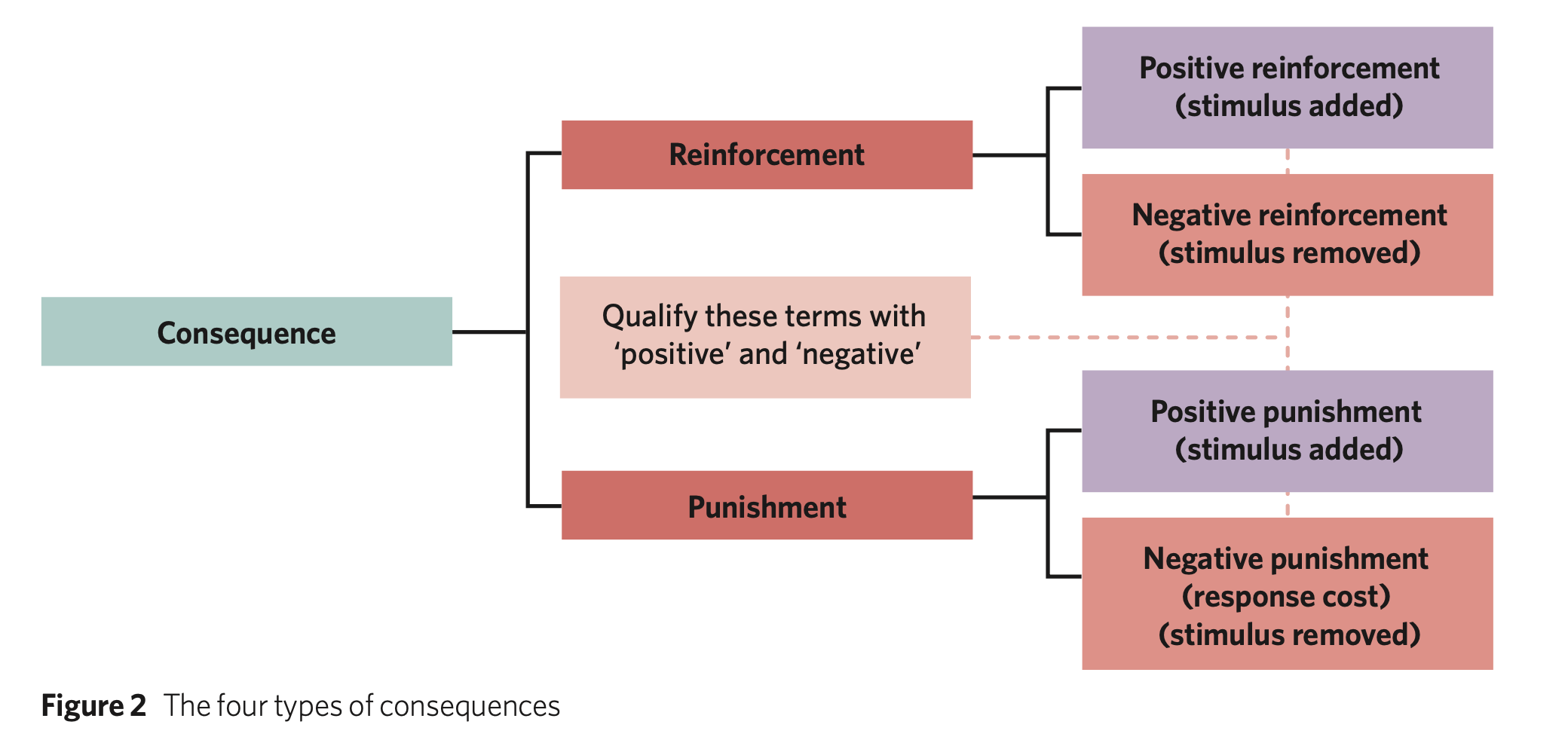
Examples of Operant Conditioning
Positive reinforcement
Presenting a desired stimulus
Sudying hard and then receiving a high mark. High mark = positive reinforcement. Therefore, increases the likelihood that the behaviour (studying hard) will reoccur.
Negative reinforcement
Removing an undesirable stimulus
Going for a run when you are stressed, which in turn helps to alleviate your feelings of stress. The removal of the undesirable experience of tension and discomfort acts as negative reinforcement for the behaviour of going for a run when you are stressed which increases the likelihood that the behaviour (going for a run) will reoccur
Positive punishment
Addition of an undesirable stimulus
A friend criticising you for arriving late Your friend’s negative remarks acts as positive punishment for the behaviour of arriving late to a social catch-up, decreasing the likelihood that the behaviour (being late) will reoccur.
Negative punishment
Removing a desirable stimulus
Not being allowed to go to a party for bad behaviour at home. The removal of the desirable experience of going to a party acts as negative punishment for the bad behaviour at home. This decreases the likelihood that the behaviour (bad behaviour at home) will reoccur.
Classical v Operant
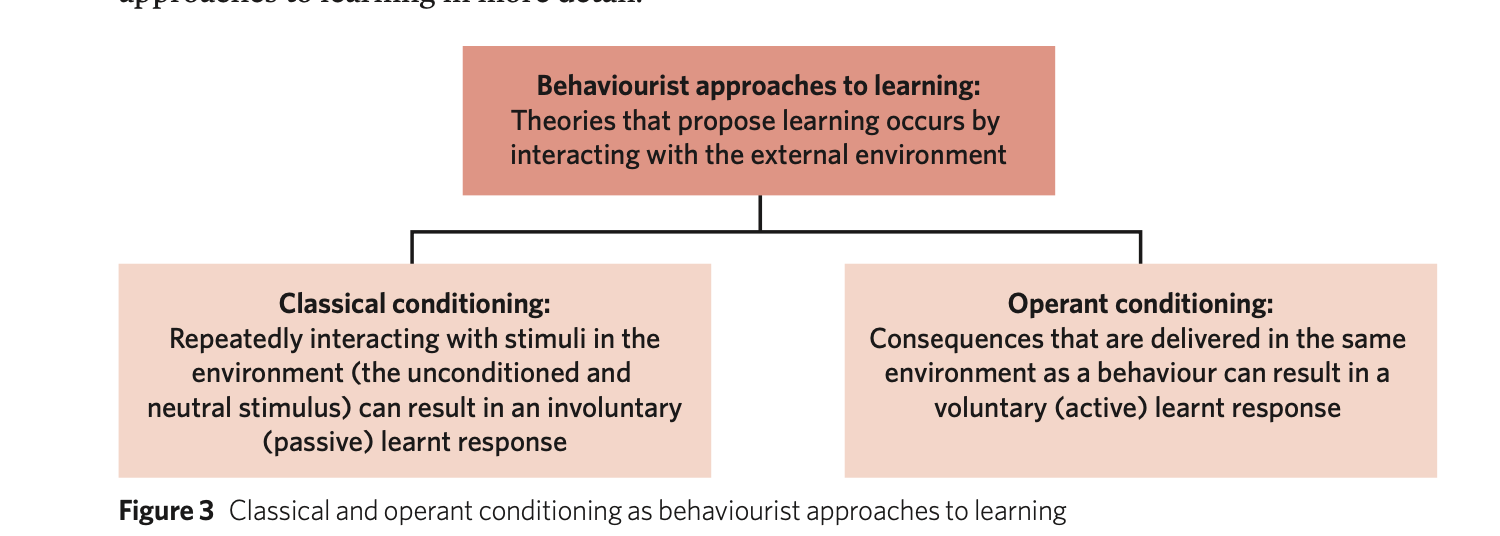
Similarities and differences between classical and operant conditioning
Similarities
Both are behaviourist approaches to learning.
Both are three-phase processes of learning.
Both require several trials in order for learning to occur. For example, during classical conditioning, the neutral
and unconditioned stimuli need to be repeatedly paired in order for learning to occur. In operant conditioning, learning is more likely to occur if the consequence occurs several times in response to a behaviour.
Differences
Operant conditioning involves learning a voluntary behaviour, whereas classical conditioning involves learning an involuntary behaviour.
Learners are active during operant conditioning, whereas learners are passive during classical conditioning.
Operant conditioning requires a consequence, whereas there is no kind of consequence during classical conditioning.
Summary of operant conditioning

Social-cognitive approaches to learning
Theories that propose learning takes place in
a social setting and involves various cognitive processes
Observational learning is a social-cognitive approach to learning
Observational learning (also known as social learning, vicarious conditioning, or modelling)
A process of learning that involves watching the behaviour of a model and the associated consequence of that behaviour
In this way, we can be indirectly conditioned by watching someone else’s conditioning. This is why observational learning can also be referred to as vicarious (experienced through watching other people’s activities, rather than doing the activities yourself ) conditioning.
Model
The individual who is performing the behaviour that is being observed
The learner has an active role in learning as they need to watch and pay attention to the model in order to be able to imitate the behaviour.
Different kinds of models
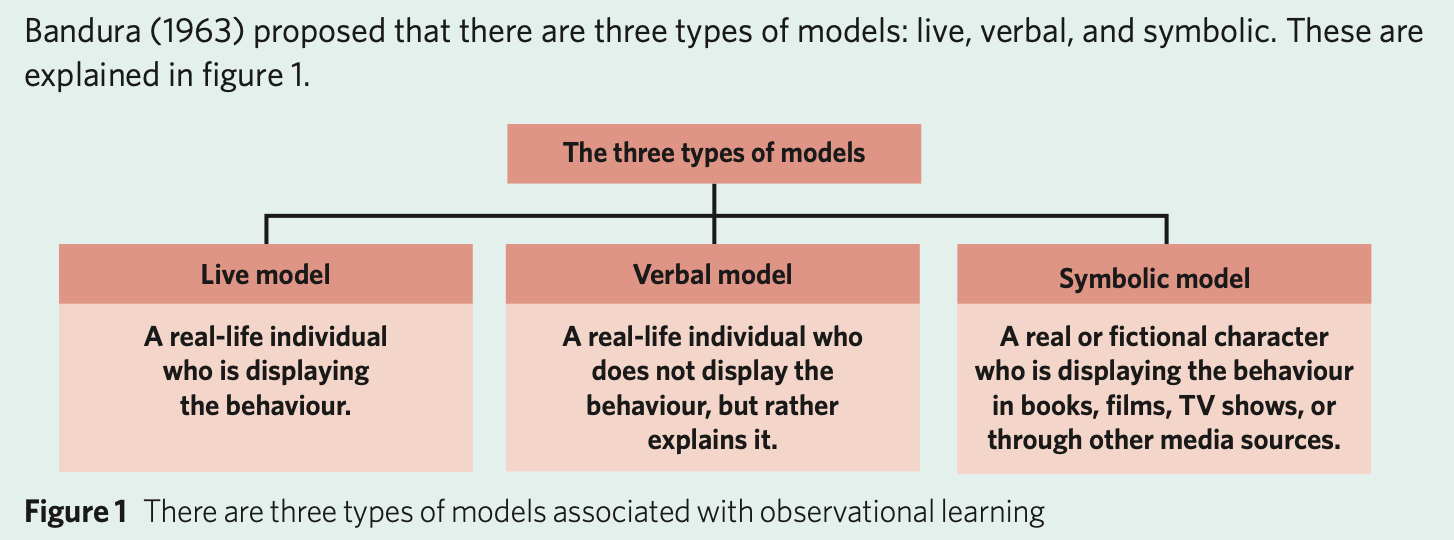
Stages of observational learning
Attention
Retention
Reproduction
Motivation
Reinforcement
Attention
Individuals actively focus on the model’s behaviour and the consequences of the behaviour
There are factors that may influence whether learners pay attention to models
Perceived positively
Liked
Of high status (such as a celebrity)
Similar to the learner
Familiar to the learner
Visible and stands out from others
Behaving in a way that the learner believes can be imitated
Retention
Individuals create a mental representation to remember the model’s demonstrated behaviour
If the individual has met this stage this means that the information they have paid attention to is stored in their memory.
This information can then be accessed later on when the individual goes to perform the behaviour.
Reproduction
The individual must have the physical and mental capabilities to replicate the behaviour
If they do not have the physical or mental ability to successfully replicate the behaviour, then they will be unable to reproduce the behaviour
Often the stage people do not achieve-tends to be easier for individuals to attend to and retain information, and have motivation than it is to gain physical and/or mental abilities.
Lack control over physical/mental capabilities
Broken leg = cannot meet reproduction for playing netball
Motivation
The individual must want to reproduce the behaviour
Motivation is a cognitive process in which individuals must desire to perform the behaviour they are observing after they have observed it. This motivation can be either intrinsic or extrinsic.
Intrinsic motivations occur from within the individual, such as the desire to perform well on an exam
Extrinsic motivations occur from factors that are external to the individual, such as the desire to receive praise from your teacher for doing well on an exam
Reinforcement
Individual receives a positive consequence for the behaviour which makes them more likely to reproduce the behaviour again in the future
Self-reinforcement: reinforced through factors internal to the individual, such as feeling proud of themselves
External reinforcement: reinforced by factors external to the individual, such as receiving an award
Vicarious reinforcement: reinforced by observing
the reinforcement of another person performing the same behaviour; can enhance the individual’s motivation and make them more likely to reproduce the behaviour again in the future, despite not being directly reinforced themselves.
An example of the five stages of observational learning
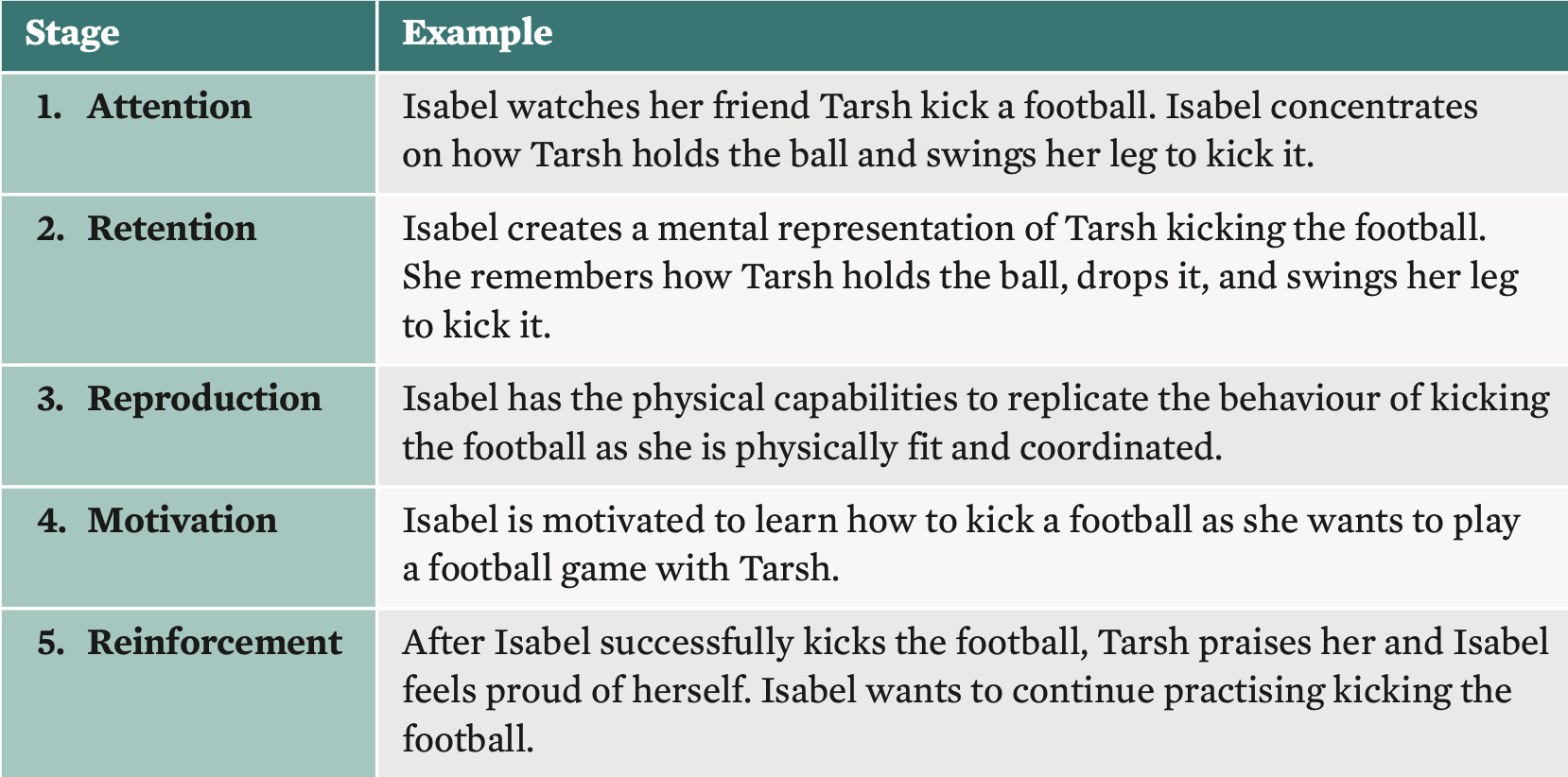
Visual summary of the processes involved in observational learning
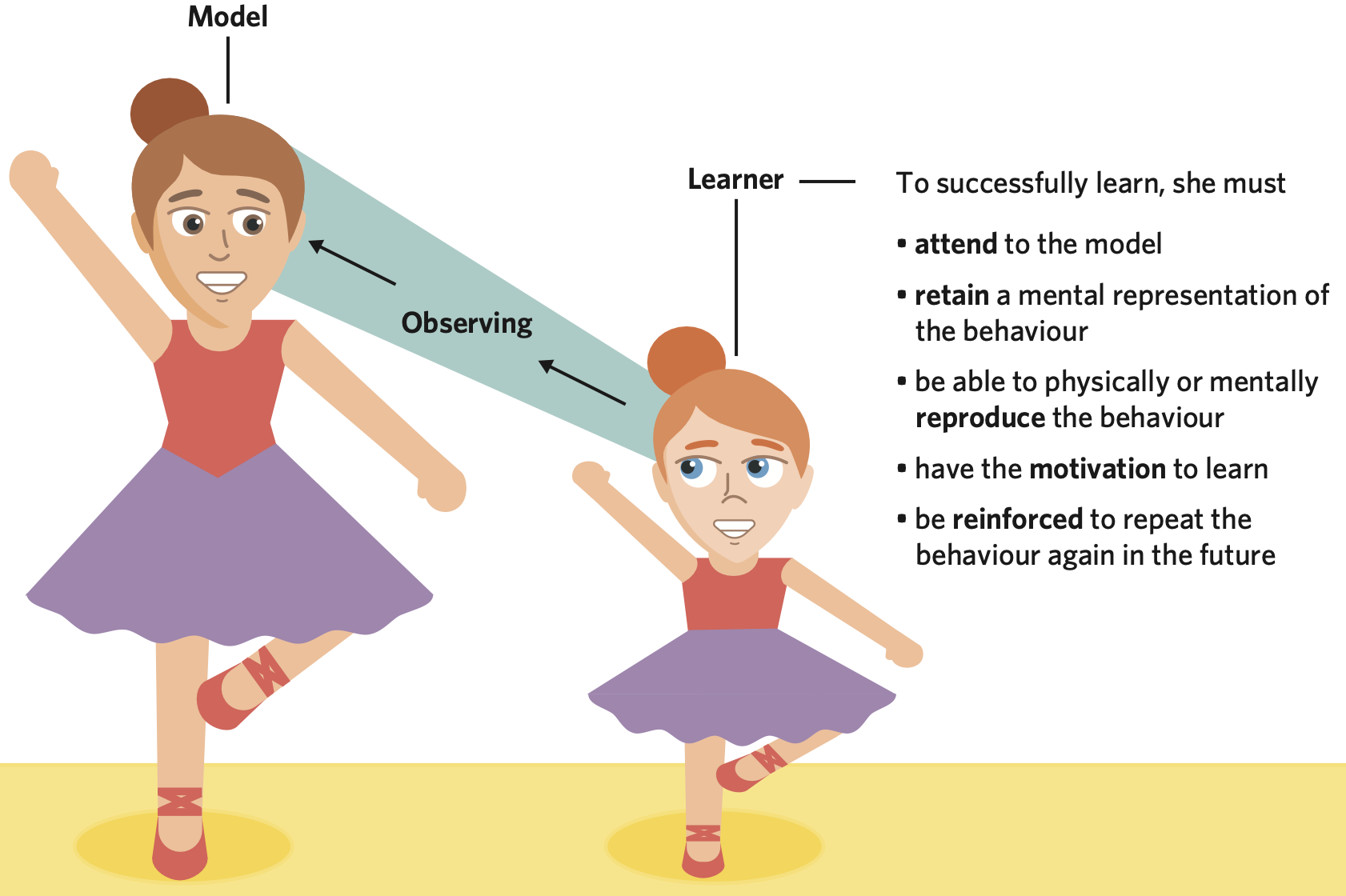
Steps of observational learning
The individual does not perform the behaviour until they progress through the stages of attention, retention, reproduction, and motivation. Reinforcement is the only stage that occurs after the behaviour is performed
(All Roads Require Maintenance Regularly)
